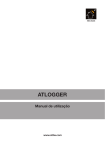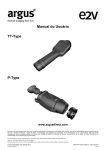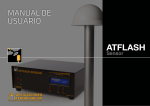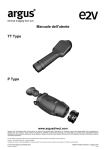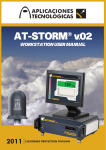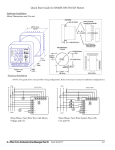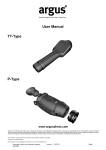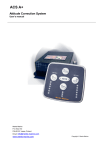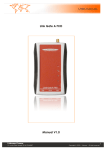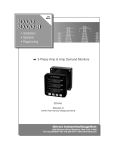Download ATLOGGER Manual - Aplicaciones Tecnológicas | Lightning
Transcript
LIGHTNING AIR TERMINALS ATLOGGER EQUIPMENT User manual www.at3w.com ATLOGGER · User Manual INDEX 1. INTRODUCTION . . . . . . . . . . . . . . . . . . . . . . . . . . . . . . . . . . . . . . 3 1.1. CONTACT . . . . . . . . . . . . . . . . . . . . . . . . . . . . . . . . . . . . . . . . . . . 3 2. DESCRIPTION . . . . . . . . . . . . . . . . . . . . . . . . . . . . . . . . . . . . . . . . 4 2.1. ATLOGGER EQUIPMENT COMPONENTS . . . . . . . . . . . . . . . . . . 4 2.2. PILOT LIGHTS . . . . . . . . . . . . . . . . . . . . . . . . . . . . . . . . . . . . . . . . 4 3. INSTALLATION INSTRUCTIONS . . . . . . . . . . . . . . . . . . . . . . . . . . 6 3.1. ATLOGGER RECORDER INSTALLATION . . . . . . . . . . . . . . . . . . . 6 3.2. SOFTWARE INSTALLATION . . . . . . . . . . . . . . . . . . . . . . . . . . . . . 6 4. ATLOGGER 4.1. INICIALIZATION . . . . . . . . . . . . . . . . . . . . . . . . . . . . . . . . . . . . . . . 8 4.2. OPERATING MODES . . . . . . . . . . . . . . . . . . . . . . . . . . . . . . . . . . . 8 4.2.1. Normal Mode . . . . . . . . . . . . . . . . . . . . . . . . . . . . . . . . . . . . . . . . . 9 4.2.2. Load ID . . . . . . . . . . . . . . . . . . . . . . . . . . . . . . . . . . . . . . . . . . . . . . 9 4.2.3. Delete ATLogger . . . . . . . . . . . . . . . . . . . . . . . . . . . . . . . . . . . . . . . 10 4.2.4. Load ID and Delete ATLogger . . . . . . . . . . . . . . . . . . . . . . . . . . . . . 10 4.2.5. Reset . . . . . . . . . . . . . . . . . . . . . . . . . . . . . . . . . . . . . . . . . . . . . . . . 10 4.2.6. Delete USB Module . . . . . . . . . . . . . . . . . . . . . . . . . . . . . . . . . . . . . 11 4.2.7. Relay Timing . . . . . . . . . . . . . . . . . . . . . . . . . . . . . . . . . . . . . . . . . . 11 5. SOFTWARE INSTRUCTIONS . . . . . . . . . . . . . . . . . . . . . . . . . . . . . 12 6. TECHNICAL DATASHEET . . . . . . . . . . . . . . . . . . . . . . . . . . . . . . . . 17 7. ACCESSORIES . . . . . . . . . . . . . . . . . . . . . . . . . . . . . . . . . . . . . . . . 18 8. ADDITIONAL TIPS . . . . . . . . . . . . . . . . . . . . . . . . . . . . . . . . . . . . . . 18 RECORDER AND USB 2 MODULE OPERATION . . . . . 8 1. INTRODUCTION ATLOGGER equipment records the electrical activity at lightning down-conductors in order to monitor direct strikes to external lightning protection systems. This manual describes the steps to be followed for the installation and operation of the ATLogger equipment, which includes the ATLOGGER recorder device, its USB storage module and the software for data reading. The ATLogger device front panel indicates the total number of recorded events. Besides, if data downloaded and processed, it can also provide the amplitude and polarity of each event together with the date and time when they occurred. It also estimates the charge and specific energy, assuming a 10/350 wave shape and according to the definitions in NF C 17-102, UNE 21186:2011 and NP 4426:2013. AT-004G 1.1. CONTACT APLICACIONES TECNOLÓGICAS, S.A. Parque Tecnológico de Valencia. Nicolás Copérnico, 4. 46980 Paterna (Valencia)-SPAIN Tel.: (+34) 96 131 82 50 Fax: (+34) 96 131 82 06 [email protected] www.at3w.com 3 ATLOGGER · User Manual 2. DESCRIPTION 2.1. ATLOGGER EQUIPMENT COMPONENTS • 1 lightning recorder. • 1 USB storage module (it is NOT a PEN DRIVE). • 1 CD containing the download software, the user manual and the USB module driver. • 1 Package with the required fixing and anchorage elements. 2.2. PILOT LIGHTS LED 1 (red) and LED 2 (green) are located inside the ATLOGGER recorder, at the batteries housing. Their function is showing the activity of the device related to initialization, operating mode and status. To see those leds, remove the external plastic and metallic covering of the ATLogger recorder. LED1 LED 1 LED 2 LED2 ATLogger USB Module is provided with 5 leds. LED 3 (green) and LED 4 (red) are the ones closer to the connector, and they indicate the status of the data transmission. LED 5 (green), LED 6 (orange) and LED 7 (red) are located on the other side: LED 3 LED 5 LED 4 4 LED 6 LED 7 Description and function of each LED: LED1: Red ON while ATLogger USB Module is inserted in the ATLogger Recorder in NORMAL working mode. OFF when ATLogger USB Module is removed and the ATLogger Recorder is operative again. LED2: Green ON while ATLogger USB Module is inserted in the ATLogger Recorder in ANY EXCEPT NORMAL working modes. OFF when ATLogger USB Module is removed and the ATLogger Recorder is operative again. LED3: Green Blinks during communication indicating data reception. LED4: Red Blinks during communication indicating data transmission. LED5: Green ON when ATLogger USB Module is inserted in a PC. During data transmission (Recorder to USB): ON when data have been completely downloaded. After data transmission: blinks if batteries are full. LED6: Orange During data transmission (Recorder to USB): ON during data downloading. After data transmission: blinks if batteries should be changed. LED7: Red ON when ATLogger USB Module is inserted in the ATLogger Recorder. After data transmission: blinks if batteries are empty. 5 ATLOGGER · User Manual 3. INSTALLATION INSTRUCTIONS The installation of two parts of the ATLOGGER Equipment are separately described: ATLogger recorder device and software installation. 3.1. ATLOGGER RECORDER INSTALLATION The marked side of the box shall be installed in contact with the down-conductor of the lightning protection system. Down-conductor disruption is not needed . Fix the ATLogger Recorder ensuring that the down-conductor touches the plastic cover of the box as shown in the figure. Installation is very easy, since the disruption of the down-conductor is not necessary and only 2 screws are required for fixing the device on a flat surface. ATLogger Recorder installation NOTE: ATLogger Equipment measures the current circulating through a down-conductor. Therefore, for an LPS provided with a single down-conductor, lightning current amplitude will be recorded. However, for an LPS with several down-conductors, only the current circulating through the down-conductor where the device is installed will be recorded. Yet, the user can insert with the software the number of conductors, and then the lightning current will be calculated assuming an equitable current sharing. 6 3.2.SOFTWARE INSTALLATION ATLogger CD contains the installation files. First, ATLogger USB driver should be installed in the PC. Then, the data download software can be also installed. The computer shall be provided with Windows XP or Windows 7 and free USB connections. For installation, insert in the computer the CD supplied with ATLogger Equipment The driver for the USB module should be installed previously to run the ATLogger software. 1. USB module driver Installation: • In the ATLogger CD, enter the folder “Driver USB_ATLogger” • Double-click “Driver_USB.exe” The process is automatic. When the installation is successfully completed, the computer shows this message: “FTDI CDM Driver Installation process completed.” 2. Data download software Installation: • In the ATLogger CD, enter the folder “Software ATLogger” • Double-click “Setup_ATLogger_X_X.exe” (where X_X is the software version). • Leave all default options and accept all steps until finishing the installation. 7 ATLOGGER · User Manual 4. ATLOGGER RECORDER AND USB MODULE OPERATION 4.1. INICIALIZATION • Fix ATLogger recorder to the wall. • Open the external plastic and metallic cover to insert 2 batteries (AA, 1.5V). Note: LiFeS2 batteries are recommended for durability and reliability reasons (eg. DURACELL ULTRA LITHIUM LF1500, manufacturer reference: 5000394099944). • When batteries are inserted, LED1 and LED2 will blink briefly. When they go off again, the system remains inactive during approx.15 seconds while the device initializes. • When this process finishes, LED2 blinks thus indicating that the device is ready to measure. More info about ATLogger Recorder initialization in ATLogger CD (ATL000 in folder “Video”). 4.2. OPERATING MODES ATLogger USB Module can work in different manners. These multiple operating modes are configurable using the software, once the ATLogger USB Module and the PC have established communication (see point 5, steps 1 to 5). With the button “Configuration”, different operating modes can be selected: Communication to ATLogger Recorder Delete USB data with the PC Communication to ATLogger Recorder dry-contacts Every time the user changes the operating mode, or when data is downloaded, the software should be re-started. In case the software or the USB Module do not respond as expected, take out ATLogger USB Module, re-start the software and re-insert ATLogger USB Module. If the problem remains, contact your distributor. Once the Operating Mode has been loaded, simply insert the Module in ATLogger Recorder to perform the required function. DO NOT remove ATLogger USB Module from the Recorder before this process has finished. 8 4.2.1. Normal Mode In Normal Mode, ATLogger USB Module loads data from the Recorder to be taken to the PC. After getting the data from the device, ATLogger USB Module indicates also batteries status, showing it with the leds. After this checking, the USB Module can be removed. The leds sequence in this mode should be as follows: 1. When ATLogger USB Module is inserted, LED7 lights 2. After a few seconds, LED6 and LED1 light. 3. When data transfer finishes, LED5 lights. 4. Then, some of the other leds (LED5, LED6 o LED7) will blink, indicating battery status: • LED5 (green): batteries ok. • LED6 (orange): batteries should be changed. • LED7 (red): batteries almost empty. 5. When ATLogger USB Module is removed, LED1 will go off (can take a few seconds). Each ATLogger Recorder has got its own identifier which is transferred along with the measurement data. Therefore, the same USB Module can read several devices. It is essential to note TIME AND DATE of the reading, as well as the number of down-conductors, since the software will request those data. More info about Normal operating mode in ATLogger CD (ATL001 in folder “Video”). 4.2.2. Load ID In Load ID Mode, ATLogger USB Module takes the ID that the user has introduced in the software (number between 0 and 255) and load that identifier in the ATLogger recorder where the USB Module is inserted. The leds sequence in this mode should be as follows: 1. When ATLogger USB Module is inserted, LED7 lights. 2. After a few seconds, LED2 lights. 3. When data transfer finishes, LED2 go off. 4. Leds LED5, LED6 and LED7 go on and off sequentially. More info about Load ID operating mode in ATLogger CD (ATL002 in folder “Video”). 9 ATLOGGER · User Manual 4.2.3. Delete ATLogger In Delete ATLogger Mode, ATLogger USB Module deletes all data existing in the ATLogger Recorder where the user inserts the Module. This function avoids memory overflow when more than 40 events have been stored. The leds sequence in this mode should be as follows: 1.When ATLogger USB Module is inserted, LED7 lights. 2.After a few seconds, LED2 lights. 3.When data transfer finishes, LED2 go off and LED5 lights. When LED5 is on, the USB Module can be removed (then LED1 may light during a few seconds). More info about Delete ATLogger operating mode in ATLogger CD (ATL003 in folder “Video”). 4.2.4. Load ID and Delete ATLogger This mode is a combination of the two preceding ones, i.e. the ATLogger USB Module deletes all data existing in the ATLogger Recorder and loads there the identifier that the user has introduced in the software. The leds sequence in this mode should be as follows: 1.When ATLogger USB Module is inserted, LED7 lights. 2.After a few seconds, LED2 lights. 3.When data transfer finishes, LED2 go off and LED5 lights. When LED5 is on, the USB Module can be removed (then LED1 may light during a few seconds). More info about Load ID and Delete ATLogger operating mode in ATLogger CD (ATL004 in folder “Video”). 4.2.5. Reset In Reset Mode, ATLogger USB Module loads the factory settings in the Recorder and restarts it (the internal clock is set to 0, as well as the memory and the identifier, although the external electromechanic counter remains with the same value) The leds sequence in this mode should be as follows: 1.When ATLogger USB Module is inserted, LED7 lights. 2.After a few seconds, LED2 lights. 3.When data transfer finishes, LED2 go off and LED5 lights. When LED5 is on, the USB Module can be removed. 4.The device restarts following the usual sequence, that is, a blink of LED1 and LED2 and, after approx.15 seconds, a blink of LED2 indicating that the device is ready to measure. More info about Reset operating mode in ATLogger CD (ATL005 in folder “Video”). 10 4.2.6. Delete USB Module In Delete USB Module Mode, all data stored in the ATLogger USB Module are deleted. This process is irreversible, so make sure that all data are properly stored in a PC before deleting them in ATLogger USB Module. The leds sequence in this mode should be as follows: 1.When ATLogger USB Module is inserted in the PC, LED5 lights. 2.In “Configuration”, select “Delete USB”. When this command is sent, Leds LED5, LED6 and LED7 light for a few seconds. 3.When the process finishes, only LED5 remains on. More info about Delete USB Module operating mode in ATLogger CD (ATL006 in folder “Video”). 4.2.7. Relay Timing In Relay Timing Mode, time values for controlling the dry contact module (only if it is installed in the ATLogger Recorder) can be defined. Ton and Toff define the times while the dry contact is active and inactive. Times are defined in seconds and they can range up to 54000 seconds (15 hours). The leds sequence in this mode should be as follows: 1.When ATLogger USB Module is inserted, LED7 lights. 2.After a few seconds, LED2 lights briefly and go off. 3.Leds LED5, LED6 and LED7 go on and off sequentially. From this stage, the USB Module can be removed. More info about Relay Timing operating mode in ATLogger CD (ATL007 in folder “Video”). 11 ATLOGGER · User Manual 5. SOFTWARE INSTRUCTIONS For a correct use of ATLogger data reading Software, please follow carefully the following points: 1.Run ATLogger application 2.Insert ATLogger USB Module in an available USB port of the PC where the driver and the software have been previously installed. Wait for the message indicating that the software is ready for use. 3.Identify the port that your PC has assigned to the inserted USB Module. For this, open “Control Panel” and then “Device Manager”. Browse “Ports (COM & LPT)” and identify the port assigned to the USB Module. If the assigned port is higher that 8, change it following these steps: a) Identify the assigned port in the Device Manager. 12 b) Click the right button of the mouse and then “Properties”. c) In “Port Settings”, click “Advanced...” d) Select a free port, different from the one assigned by the PC. e) Click “OK” and re-start the computer if required. 13 ATLOGGER · User Manual 4.Go to ATLogger software. In “Select port”, choose the appropriate port number form the drop-down list. Click “Connect” and wait for the confirmation message. 5.Download the data from the ATLogger USB Module. This window allows also to select “Configuration” for changing the Operating Modes of the ATLogger USB Module. For more information about Configuration see 4.2. 14 6.When data have been downloaded, the software requests date and time when each installation was read, as well as its number of down-conductors. 7.Finally the data are displayed, indicating the installation identifier, current polarity and amplitude (in kiloamps), charge (in Culombs) and specific energy (in kJ/Ω). These two last parameters are calculated assuming a 10/350µs waveshape and calculations given in Clause C.3.4 of the standards NF C 17-102, UNE 21186:2011 and NP 4426:2013. 15 ATLOGGER · User Manual 8. Save data in a file, typing the name of the file. By default the software assigns the extension for spreadsheet (“data.xls”) although other extensions can be used, eg. ”data.doc” will generate a word file, “data.txt” will generate a text file, etc. Extensions should be related to software installed in the PC and able to read ASCII characters. More info about data download and saving in ATLogger CD (ATL008 in folder “Video”). 16 6. TECHNICAL DATASHEET Operational Detection range: 2kA (8/20µs) to 100kA(10/350µs) Resolution: 1kA Response time: 100ns Minimum time between consecutive events: 10s Storage capacity: 40 events Electrical Power supply: 2 batteries AA, 1.5V (LiFeS2, 3000mA/h batteries recommended) Batteries lifetime: Between 1 and 2 years depending on the activity Mechanical Dimensions: 160x80x55 mm External enclosure material: Polycarbonate V0 (flammability acc.to UL94 V0) Internal enclosure material: EMI aluminium alloy Fixing: 2 screws to wall (other fixings under request) Environmental Working temperature: -20 to 50 ºC Storing temperature: -40 to 50 ºC External enclosure watertight: IP65 Internal enclosure watertight: IP65 17 ATLOGGER · User Manual 7. ACCESSORIES AT-005G Reference Description AT-005G Galvanised steel plate for fixing to mast 8. ADDITIONAL TIPS • Batteries should be changed every year, approximately, or after a period of high lightning activity, for example if the front panel readings indicate a high number of strikes. • Batteries replacement should be performed avoiding unnecessary re-starts of the device. Stored data don’t get lost when batteries are empty or being replaced. • In case of malfunction or lack of response of the USB module in any operating mode, take it out and repeat the process after one or two minutes. If the problem remains, contact your distributor. • In case of malfunction of the ATLogger recorder, re-start the device by taking out and in again the batteries. Check also the status of the batteries. If the problem remains, contact your distributor. • The CD included in the equipment contains several videos showing the working of ATLogger equipment in all operating modes. 18 NOTES 19 www.at3w.com Aplicaciones Tecnológicas, S.A. - Parque Tecnológico de Valencia - C/ Nicolás Copérnico, 4 - 46980 Paterna (Valencia), Spain Tlf: (+34) 96 131 82 50 - Fax: (+34) 96 131 82 06 - [email protected] - www.at3w.com






















